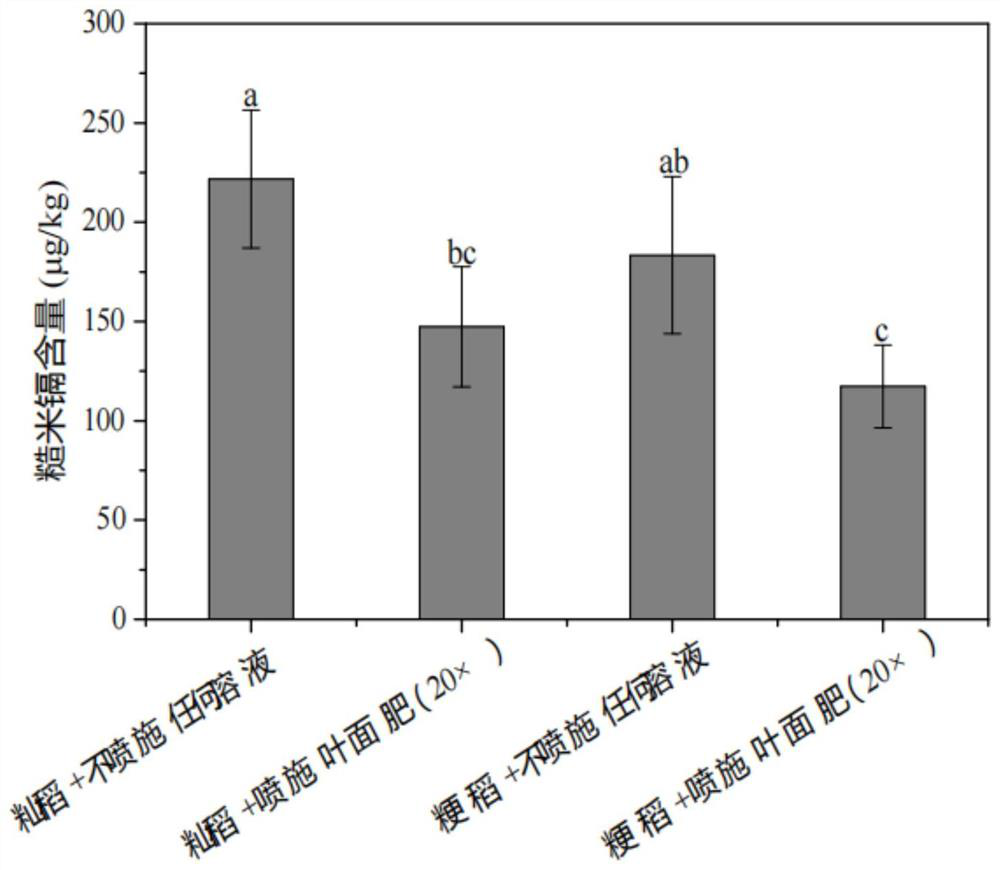Synthesis of leaf surface blocking agent for efficiently reducing cadmium accumulation of indica rice and japonica rice and application method thereof
A technology of application method and synthesis method, which is applied in the field of synthesis of foliar barrier agents, can solve problems such as difficult rice leaf absorption, and achieve the effects of enhancing detoxification ability, reducing cadmium pollution, and inhibiting migration and accumulation
- Summary
- Abstract
- Description
- Claims
- Application Information
AI Technical Summary
Problems solved by technology
Method used
Image
Examples
preparation example Construction
[0029] refer to Figure 1-2 , a synthetic method for efficiently reducing cadmium accumulation in indica rice and japonica rice, characterized in that it comprises the following steps:
[0030] Step 1: Synthesis of iron sodium salt solution of EDTA: Weigh 2.00g of ferrous sulfate tetrahydrate and 2.00g of disodium EDTA, dissolve them in 200ml of ddH 2 O and mix well.
[0031] Step 2: Add 3.00 g of zinc sulfate heptahydrate, and dissolve in a water bath at 60°C.
[0032] Step 3: Add 3.00 g of sodium metasilicate nonahydrate, and dissolve in a 60°C water bath.
[0033] Step 4: Add 3.00g of succinic acid, dissolve in a water bath at 60°C and adjust the volume to 1000ml.
[0034] A method for synthesizing and applying a foliar barrier that efficiently reduces the accumulation of cadmium in indica and japonica rice. The above solution is diluted 20 times and sprayed with 30 liters per mu of rice.
[0035] Synthesis and application of a highly effective foliar barrier to reduce ...
Embodiment 1
[0046] Example 1: The background value of cadmium in the experimental soil is 0.23mg / kg, the pH value is 7.2, and the cation exchange capacity is 17.01±3.08cmol / kg. The experimental groups are as follows:
[0047] (A) No exogenous Cd added to the soil + ddH sprayed only 2 O;
[0048] (B) 3.0mg / kg Cd contaminated soil + ddH spraying only 2 O;
[0049] (C) 3.0mg / kg Cd contaminated soil+spray foliar fertilizer dilution (40×);
[0050] (D) 3.0mg / kg Cd contaminated soil + spraying foliar fertilizer dilution (20×);
[0051](E) 3.0mg / kg Cd contaminated soil + spraying foliar fertilizer dilution (10×). Each treatment group was sprayed with diluent from the end of jointing stage, sprayed once every week, and sprayed 3 times in a row. Three pots of indica rice (Longjingyou 570) and three pots of japonica rice (Nanjing 9108) were planted in each treatment group. The growth period is from mid-May 2019 to early October 2019, cultivated in the open air until the rice matures. The co...
Embodiment 2
[0052] Example 2: The pH value of the paddy field soil is 7.1, and the total cadmium content is 2.27±0.41 mg / kg. Select 4 paddy fields with similar area to carry out the following experiments:
[0053] Experimental area A: Indica rice was planted, and no reagent was sprayed;
[0054] Experimental area B: Indica rice was planted, and a diluted solution of cadmium foliar barrier (20×) was sprayed;
[0055] Experimental area C: Plant japonica rice without spraying any reagents;
[0056] Experimental area D: Japonica rice was planted, and a diluted cadmium foliar barrier solution (20×) was sprayed.
[0057] Each test area was sprayed with diluent from the end of jointing stage, sprayed once every week, and sprayed continuously for 3 times. The growing period is from late May 2020 to late October 2020. ICP-MS was used to determine the cadmium content in brown rice, and the results of the field experiment were as follows: figure 2 shown. Compared with the non-sprayed group of...
PUM
 Login to View More
Login to View More Abstract
Description
Claims
Application Information
 Login to View More
Login to View More - R&D
- Intellectual Property
- Life Sciences
- Materials
- Tech Scout
- Unparalleled Data Quality
- Higher Quality Content
- 60% Fewer Hallucinations
Browse by: Latest US Patents, China's latest patents, Technical Efficacy Thesaurus, Application Domain, Technology Topic, Popular Technical Reports.
© 2025 PatSnap. All rights reserved.Legal|Privacy policy|Modern Slavery Act Transparency Statement|Sitemap|About US| Contact US: help@patsnap.com


